This post may contain affiliate links. For more information, please see our affiliate policy.
Learn how to cook farro perfectly and enjoy its wonderful nutty flavor in salads, soups, or all by itself as a simple side.
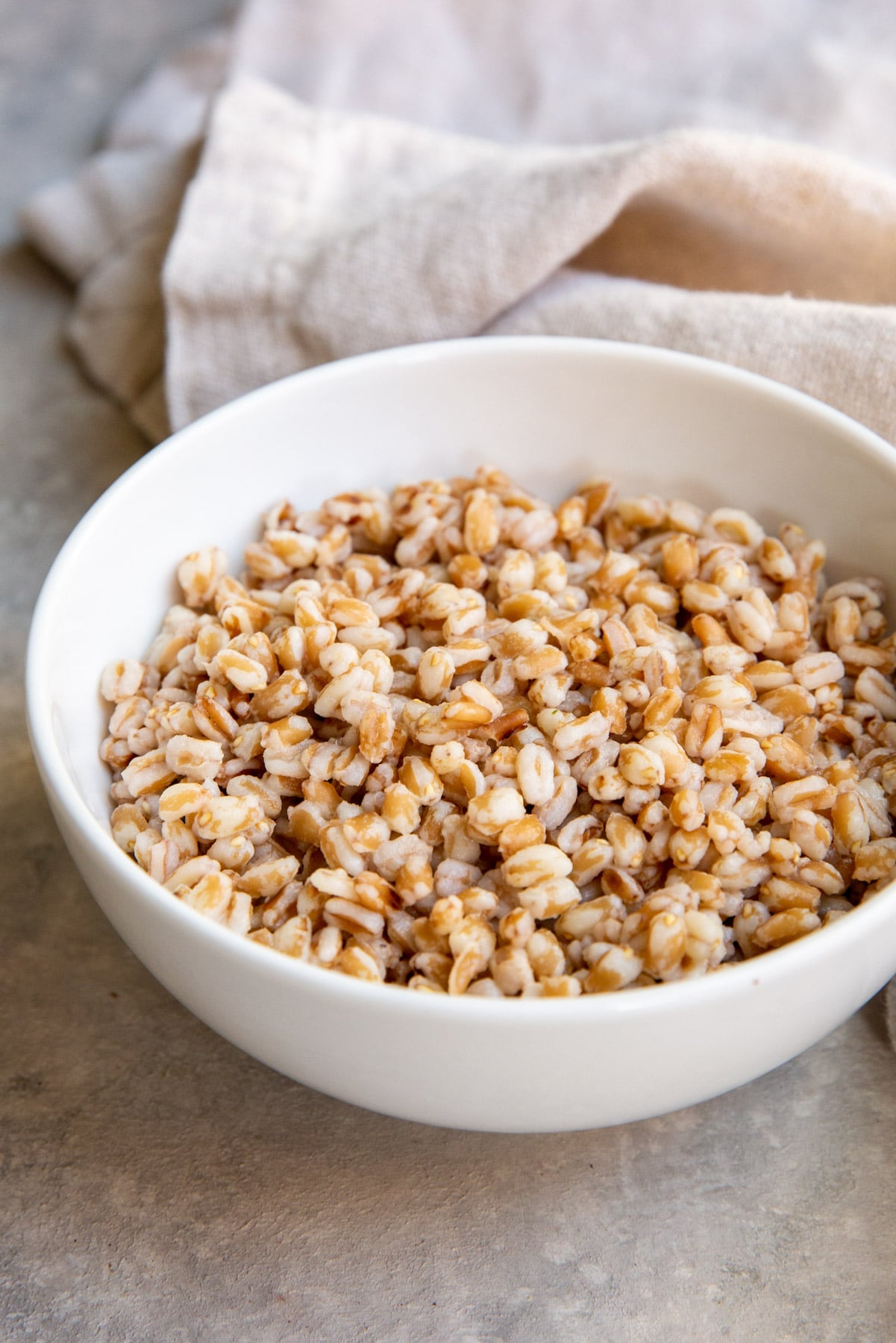
Recipes using farro may be relatively new to the U.S., but Middle Eastern and Italian cuisine has included farro for thousands of years. Some people use the name “spelt,” but that’s not always 100% accurate. Technically, farro and spelt are two distinct types of wheat grain, neither of which are gluten-free.
Once you know what to look for and how to read the labels on different packages of farro, cooking is a breeze.
Table of Contents
Ingredient notes
There are three main types of farro (farro is usually found in well-stocked grocery stores with other whole grains such as rice, quinoa, and wheat berries).
- Pearled farro: The most common type found in American groceries. It has more of the outer husk removed and cooks the fastest, about 10 to 15 minutes.
- Semi-pearled farro: About half of the grain’s husk and bran has been removed in the pearling process, making semi-pearled farro cook a little bit quicker than whole grain.
- Whole farro: The entire grain is left intact (with little to no extra processing). Whole farro has the most flavor (and the most nutrients). However, that also means that it takes the longest to cook, 30 to 40 minutes.
Step-by-step instructions
These instructions are for pearled and semi-pearled farro.
- In a medium saucepan, heat olive oil over medium-high heat until shimmering. Add farro and cook, stirring until fragrant, about 2-3 minutes.
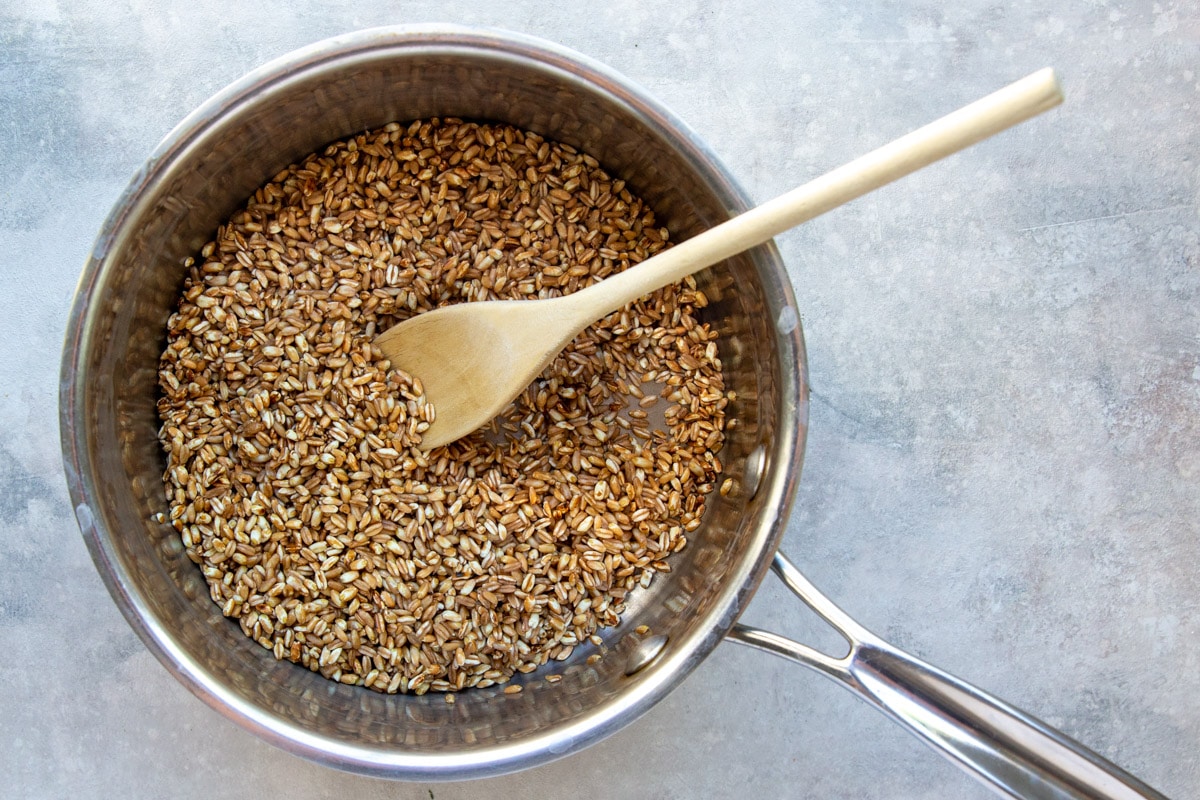
- Add water and 1 teaspoon and bring to boil. Reduce heat to low, cover, and simmer until farro is tender, about 15-18 minutes.
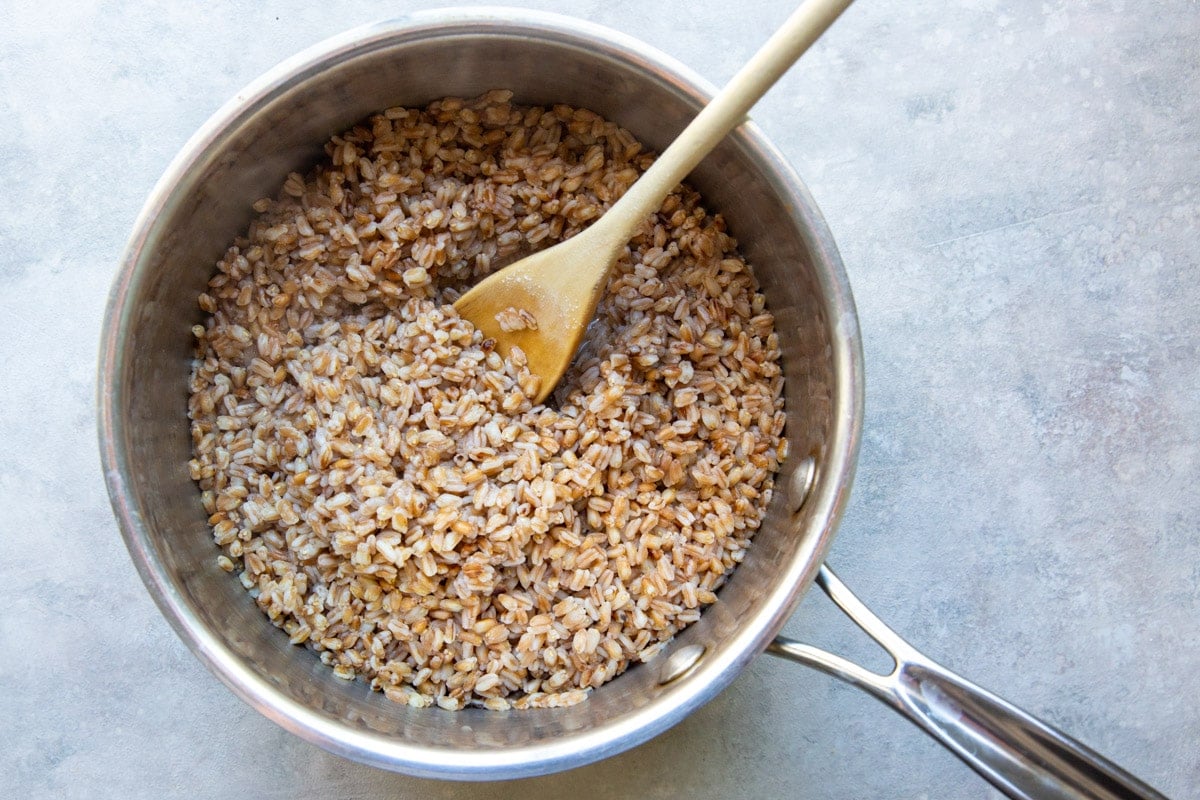
- Drain through a fine-mesh sieve.
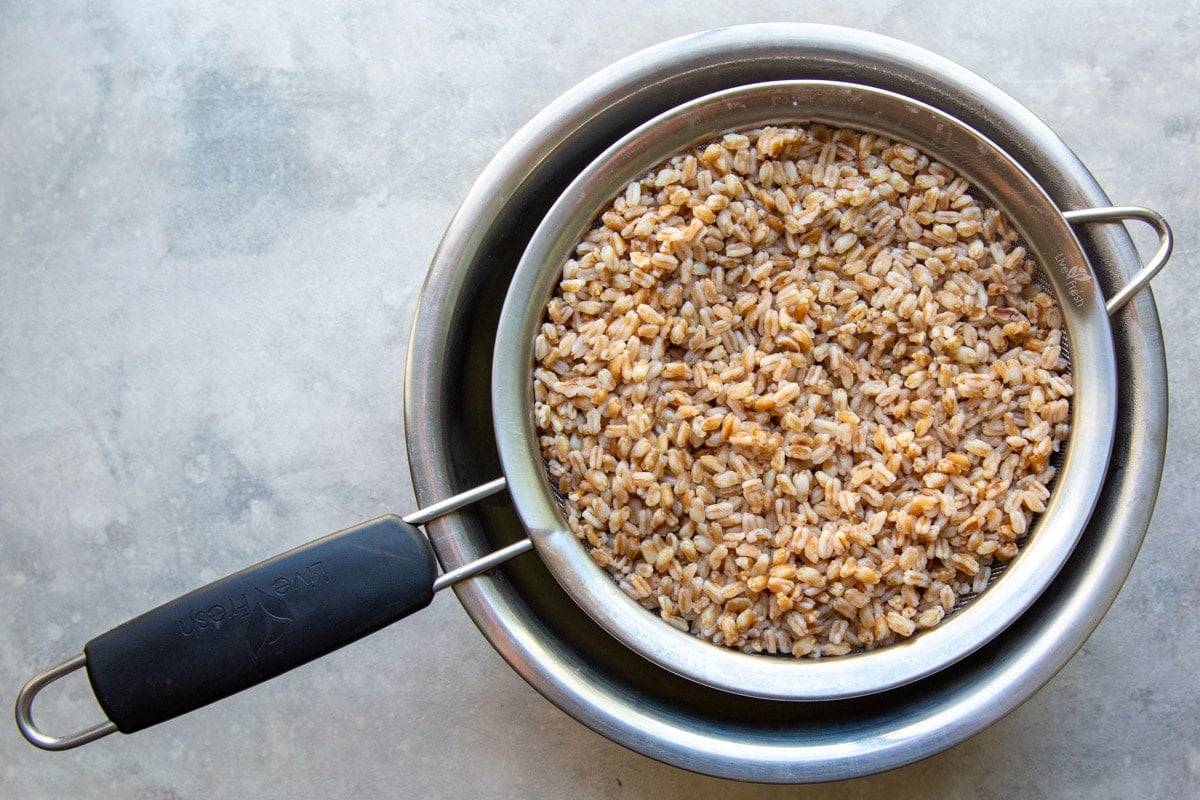
- Serve warm or spread farro out in a single layer on a rimmed baking sheet to cool to room temperature.
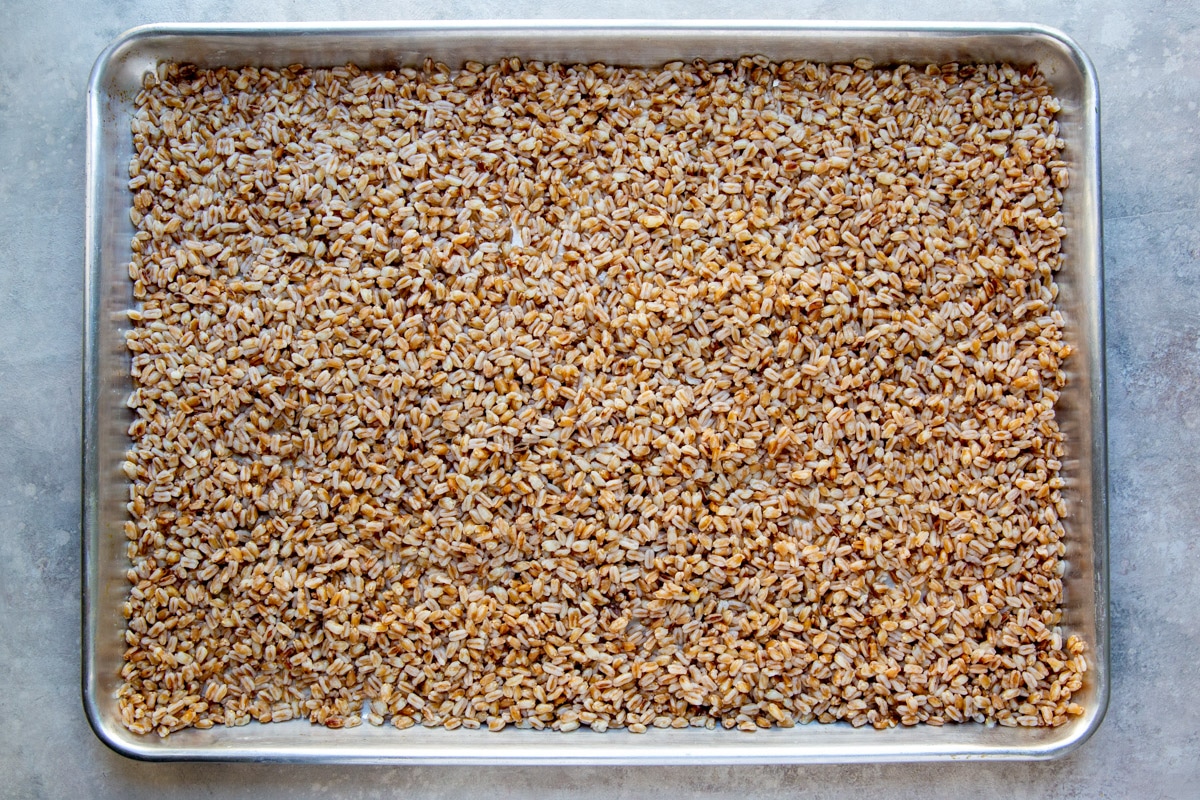
Recipe tips and variations
- Yield: This recipe (2 cups dried farro) makes about 5 cups cooked farro, or 10 servings (½ cup each).
- Storage: Cooked, cooled farro keeps in the refrigerator for up to 4 days.
- Freezer: To keep the grain from clumping together as it freezes, spread it out on a sheet tray in the freezer. Once frozen, store in a freezer-safe container. Thaw overnight in the refrigerator or defrost in the microwave.
- Pre-toasting: Toasting the grains before cooking adds so much flavor. You can lightly toast farro grains in the oven (spread the dry grains out on a rimmed baking sheet and toast in an oven set at 350 degrees until lightly browned, about 10 to 15 minutes) or on the stove (cook the dry farro in a dry skillet over medium heat stirring frequently, until lightly browned).
- Cooking whole farro: Add farro to a large pot of boiling, salted water. Bring the pot back to a boil, then reduce the heat to a simmer. Cook until the grains are tender but not mushy, about 30 to 40 minutes. Pull out a grain after the 15-minute mark to test for tenderness. Drain off the excess water and spread the cooked farro out on a baking sheet to cool.
- Add aromatics: This healthy grain is a healthy blank canvas for whatever flavors you want to incorporate. Simmer it in chicken broth, apple cider, or add some vegetables (carrot, celery, bay leaf, herbs, onion) to the pot as it cooks.
- Cool it: Be sure to let the cooked farro cool before adding to a salad. The outer layer of the grain benefits from a chance to dry out a bit, which prevents it from getting too soft. That makes it stand up to vinaigrettes and sauces better.
- Serving suggestions: Serve warm as a twist on rice pilaf with a drizzle of good olive oil, a little salt and pepper, and a squirt of lemon juice. Or, you can add a scoop or two to any brothy soup. And of course, you can toss it in with just about any salad.
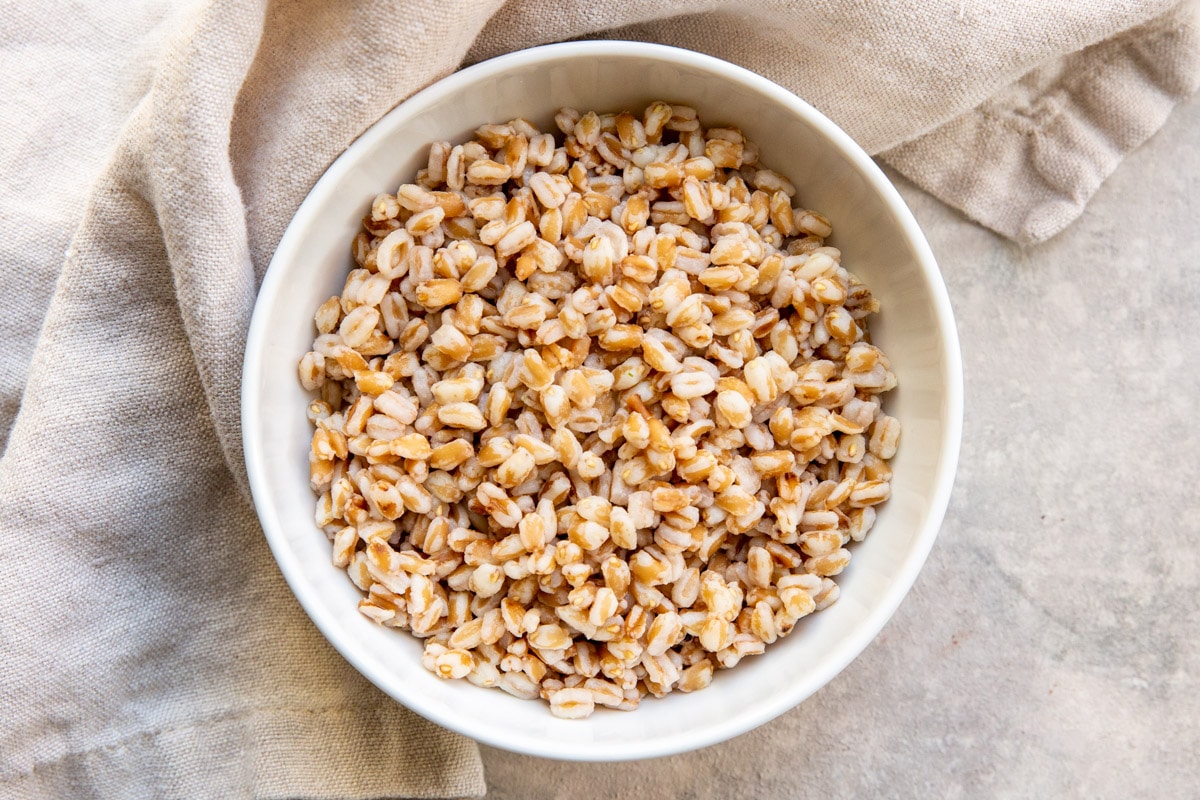
Frequently Asked Questions
Unlike quinoa (at least the un-rinsed kind), farro doesn’t need to be rinsed before cooking. It’s never a bad idea to rinse grains before cooking in general, though.
Harvest Bowl
This hearty Harvest Bowl is made with rosemary-roasted butternut squash, farro, kale, pecans, apples, pomegranate seeds, and feta cheese tossed in an apple cider vinaigrette with a splash of maple syrup. The hearty kale holds up well for meal prep, and the whole salad is colorful and nutritious.
View RecipeJoin Us
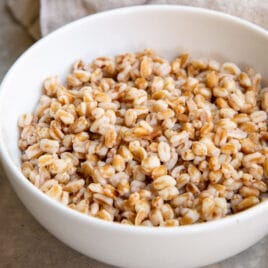
How to Cook Farro
Ingredients
Instructions
- In a medium saucepan, heat olive oil over medium-high heat until shimmering. Add farro and cook, stirring until fragrant, about 2-3 minutes.
- Add water and 1 teaspoon salt, and bring to a boil. Reduce heat to low, cover, and simmer until farro is tender, about 15-18 minutes. Drain through a fine-mesh sieve, then serve warm or spread farro out in a single layer on a rimmed baking sheet to cool to room temperature. Season to taste with salt.
Recipe Video
Notes
-
Farro: There are the three main types (farro is usually found in well-stocked grocery stores with other whole grains such as rice, quinoa, and wheat berries).
- Pearled farro: The most common type found in American groceries. It has more of the outer husk removed and cooks the fastest, about 10 to 15 minutes.
- Semi-pearled farro: About half of the grain’s husk and bran has been removed in the pearling process, making semi-pearled farro cook a little bit quicker than whole grain.
- Whole farro: The entire grain is left intact (with little to no extra processing). Whole farro has the most flavor (and the most nutrients). However, that also means that it takes the longest to cook, 30 to 40 minutes.
- Yield: This recipe (2 cups dried farro) makes about 5 cups cooked farro, or 10 servings (½ cup each).
- Storage: Cooked, cooled farro keeps in the refrigerator for up to 4 days.
- Freezer: To keep the grain from clumping together as it freezes, spread it out on a sheet tray in the freezer. Once frozen, store in a freezer-safe container. Thaw overnight in the refrigerator or defrost in the microwave.
Nutrition
Meggan Hill is a classically-trained chef and professional writer. Her meticulously-tested recipes and detailed tutorials bring confidence and success to home cooks everywhere. Meggan has been featured on NPR, HuffPost, FoxNews, LA Times, and more.
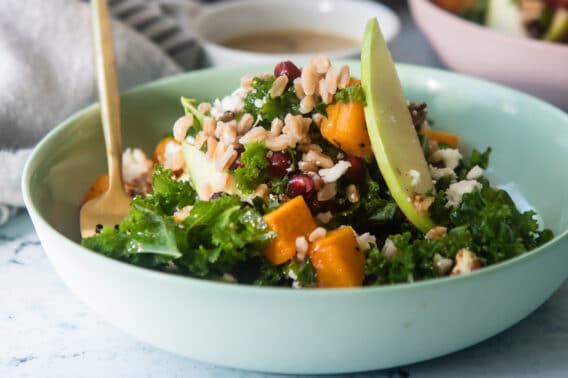
How do you reheat farro
Hi Dory, you can reheat farro in the microwave or in a skillet. If you do the microwave, I would add a tiny amount of water (a splash, maybe a teaspoon or so) and cover with plastic wrap, them microwave in 30 second intervals (or more if you have a lot). In a skillet, you could do a dry skillet, add a splash of water, or start with some olive oil and heat that up first. I hope this helps! Thank you very much! Have a great week and take care. -Meggan
Hi I read your article with interest. I am on a new diet and one of the foods that was suggested for vegans was farro.
I ordered some from Amazon In looking at the calories, I noted that the number of calories for 1/4 cup was 190. Somewhere else was an article (not yours) which stated that 123 was the amount for 1/4 cup. Is the difference in the kind of pearling? I see some is partially pearled, completely pearled, not pearled at all. Could you let me know which is the healthiest kind of farro, the lowest caloried farro, and a count of the calories. I am weighing and measuring my food and have a limited amount of calories I can eat with each meal and I want to eat enough and not too much. 190 for farro seems a lot for 1/4 cup. How ever if it is 190 I will give it a try. Also if you have any information about couscous and quinoa I would appreciate learning about their amounts calories etc. recipes or anything you could share. It would be greatly appreciated. I am greatful for the cooking suggestions and the recipes. They look delicious. Can’t wait to try them.
Hi Elaine, thank you so much for your comment. I hope I can help! I’m glad you’re already using a food scale, that’s the best way to get a more accurate measure instead of by volume. I recommend using an app that will allow you to track nutritional information and has a function where you can scan the barcode on the package and most times will have the nutritional facts already in the program. The program I use to generate nutritional facts is an estimate, and it doesn’t allow me to choose farro by types to compare calorie counts. It estimates 153 calories per 1/2 cup cooked farro. I’m not a nutritionist or a doctor, but sources say whole farro is the most nutritionally dense since the grain is intact.
I would love to share a couple links with you!
Here is my favorite couscous salad (made with Israeli couscous): https://www.culinaryhill.com/israeli-couscous-salad/
This is my favorite quinoa salad (also vegan!): https://www.culinaryhill.com/mediterranean-vegan-bowl/
This post shows step-by-step how to cook quinoa: https://www.culinaryhill.com/how-to-cook-quinoa/
And here’s a category page for working with other grains and legumes I think you might find helpful:
https://www.culinaryhill.com/how-to/grains-and-legumes/
I hope you love these recipes, and please let me know if you have any more questions, I would love to help! – Meggan
Hi,
I first discovered Farro at a Mediterranean restaurant near me, called Zoës kitchen. It was a franchise that probably does shut down during Covid here and Colorado Springs. Since then I have been looking high and low for a recipe that some thing of a Caprese/Mediterranean Farro. Do you have any recommendations of recipes with Farro besides this one that you published. My other new discovery has been Kumat as well… Always open to new recipes with unique grains.
I love your recipes by the way! You’re such an excellent chef!
Hi Vicki! Thank you so much for your lovely comment! I do have another recipe – Farro Salad with Peas and Feta with a Lemon Dressing: https://www.culinaryhill.com/farro-salad-with-peas-and-feta/. It’s so fresh and delicious! You could also substitute farro for the couscous in the Mediterranean Buddha Bowl: https://www.culinaryhill.com/mediterranean-vegan-bowl/. I hope you love these! Take care! – Meggan